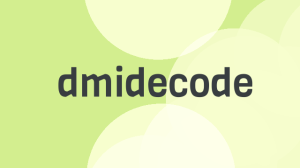Archive for August, 2017
Get System Info with dmidecode
Posted by delightlylinux in linux on August 28, 2017
📅 August 28, 2017
 The Desktop Management Interface (DMI) is a vendor-neutral, standardized framework for managing and gathering information about a computer system.
The Desktop Management Interface (DMI) is a vendor-neutral, standardized framework for managing and gathering information about a computer system.
Which memory slots are populated?
What is the BIOS revision number?
What ports are located on the motherboard?
What is the processor version?
Using a program called dmidecode, these questions and many, many other technical details can be retrieved and displayed at the command line without having to open your computer case and reading tiny print on labels or in poorly-translated multi-lingual manuals.
As long as your hardware supports the DMI protocol, which is almost all modern hardware these days, then you can view the information using dmidecode.
Do you need to know the configured clock speed of your RAM? dmidecode will report the speed without needing to reboot into BIOS. Sure, fancy GUI programs, such as hardinfo, report identical information, but sometimes you simply want to impress your inner geek with command-line goodness.
View ASCII Art System Info with Neofetch
Posted by delightlylinux in linux on August 24, 2017
📅 August 24, 2017
 Have you opened a terminal, such as RetroPie for the Raspberry Pi, and admired the RetroPie ASCII art logo adjacent to a brief system information listing?
Have you opened a terminal, such as RetroPie for the Raspberry Pi, and admired the RetroPie ASCII art logo adjacent to a brief system information listing?
Wouldn’t it be fun to do the same in a desktop Linux installation?
You can!
With a program called neofetch, you can view the ASCII art logo for your current distribution complete with a synopsis of system information.
Let’s Learn JavaScript • Lesson 6 • Statements and Comments
Posted by delightlylinux in Lessons on August 18, 2017
📅 August 18, 2017
 The JavaScript interpreter executes lines of code one by one from top to bottom. A statement is a line of code that tells JavaScript what to do.
The JavaScript interpreter executes lines of code one by one from top to bottom. A statement is a line of code that tells JavaScript what to do.
Statements contain keywords, which are words reserved by the JavaScript language for specific instructions. These keywords, combined with user data, form the statements that comprise a script.
Enjoy Smoother Video with SmoothVideo Project
Posted by delightlylinux in linux on August 11, 2017
📅 August 11, 2017
 Have you ever admired the smooth motion video seen on 120Hz and 240Hz HDTVs in an electronics store and thought, “Oh, wow. It would be nice to watch my videos like that!”?
Have you ever admired the smooth motion video seen on 120Hz and 240Hz HDTVs in an electronics store and thought, “Oh, wow. It would be nice to watch my videos like that!”?
Well, now you can!
SmoothVideo Project is a free/pay, cross-platform software product that converts any existing video to 60fps on a computer to produce fluid motion without the stutter or jitter inherent in many video sources due to low frame rates.
Here is my experience installing and using this fun piece of software with Linux Mint.